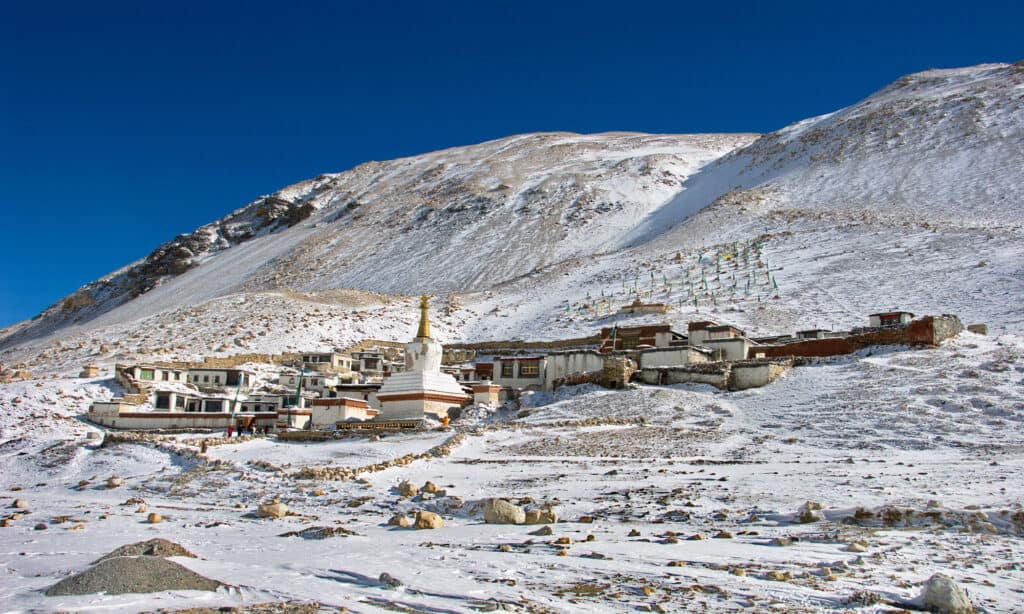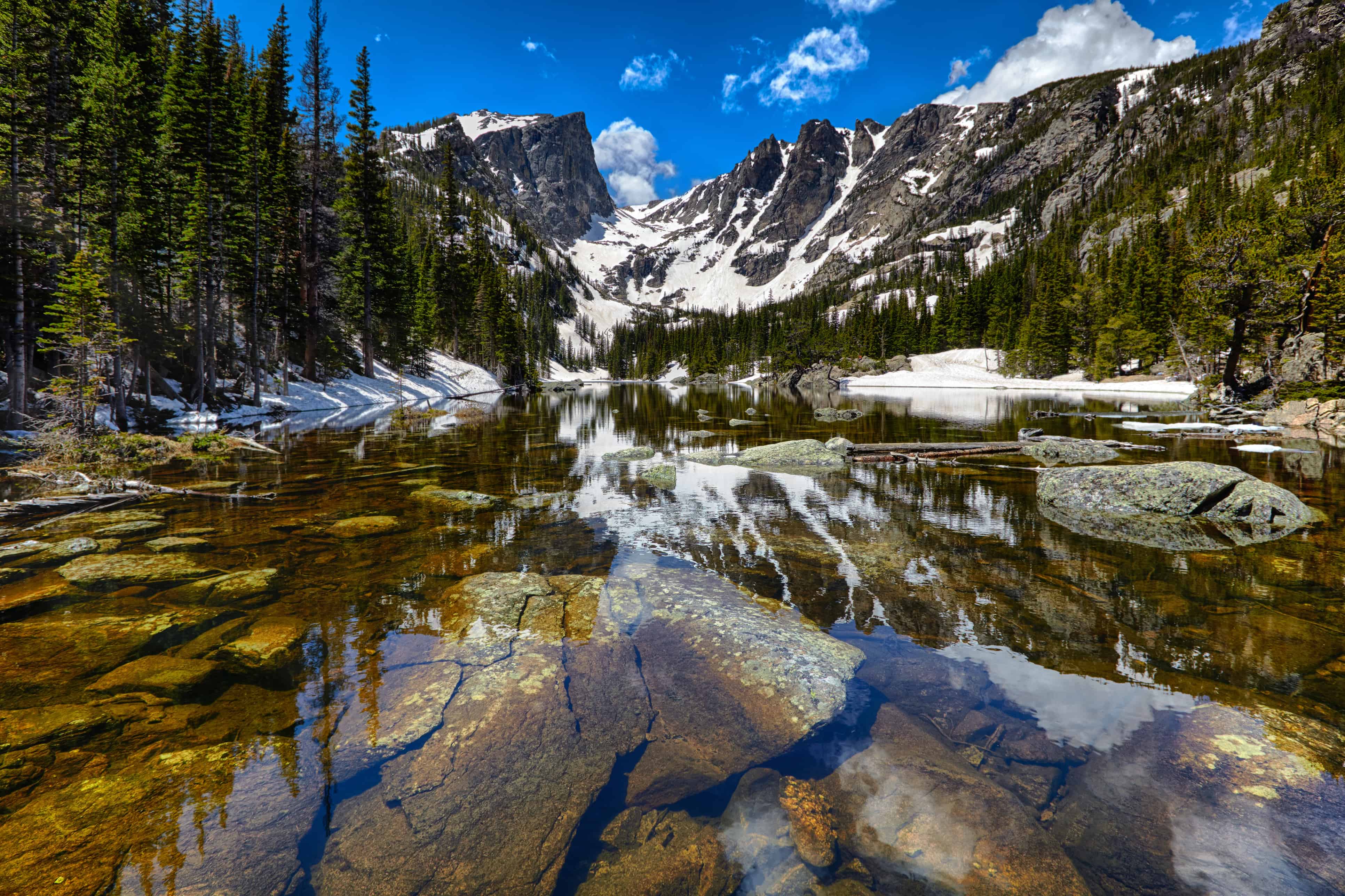Known to us as “The Rockies,” the Rocky Mountains are the majestic north to south mountain chain of North America. The Rockies stretch 3,000 miles (4,800 km) from Canada across the United States.
The mountain’s name is translated from an Amerindian name, “As-in-wati,” which means a “rocky mass.” In 1752, the current name of the mountain ranges was first mentioned by a European in the journal of Jacques Legardeur de Saint-Pierre, where they were called “Montagnes de Roche” or “Rocky Mountains,” and apparently, everyone picked up on it.
The Rockies attract thousands of hikers, mountain bikers, skiers, and outdoor enthusiasts yearly. Find out everything you need to know about the Rocky Mountains – from its climate and history to its actual age and formation.
How old are the Rocky Mountains?

The Rocky Mountains are between 50 and 80 million years old.
©iStock.com/chapin31
The Rocky Mountains are between 50 and 80 million years old. They were formed during the Laramide orogeny when several North American mountain ranges were shaped into the mountains we know today. During this time, several plates began sliding underneath the North American plate. During the Paleozoic, the western part of North America was covered by a shallow sea. Many kilometers away, a lot of limestone and dolomite were laid down.
The rocks in the Rockies were formed way before the mountain ranges were raised by further tectonic activity. The Precambrian metamorphic rock is the oldest and forms the core of the North American content. The Precambrian sedimentary argillite is another old rock that dates back 1.7 billion years. These ancestral rocks were disturbed during the mountain formation in the southern Rockies, near present-day Colorado.
How were the Rocky Mountains created?
The mountain ranges eroded throughout the late Paleozoic and early Mesozoic (between 1 billion and 190 million years ago), leaving massive deposits of sedimentary rocks. The Northern Rockies and the Canadian Rockies formed along the eastern edge of a region of carbonate sedimentation approximately 17 miles thick.
The Rocky Mountain Trench (a downfaulted, straight, flat-bottomed valley) marks the western margin of the Northern Rockies and the Canadian Rockies. In the Cretaceous Period (about 66 to 145 million years ago), the structural depression stretched from Canada to the Gulf of Mexico and became a contentious seaway. Thick sheets of Paleozoic limestone were thrust eastward over Mesozoic rocks, forming the Canadian and Northern Rockies’ ranges during the geological period of the Laramide orogeny.
Periods of glaciation occurred continuously from the Pleistocene Epoch to the Holocene Epoch (1.8 million to less than 11,000 years ago), forming extensive glacial landforms like the u-shaped valleys and cirques. These geological processes exposed numerous sets of rocks beneath the surface. For example, the severe erosion in Wyoming modified intermountain basins into relatively flat terrain, and the volcanic rock from the Neogene and Paleogene periods occurs in the San Juan mountains, among other areas.
Are the Rocky Mountains still growing?

The Rocky Mountains stopped forming massively roughly 35 million years ago.
©iStock.com/nick1803
The Rocky Mountains stopped forming massively roughly 35 million years ago. However, it’s believed they are still growing steadily in a way that’s not easily detected. The Rockies continue to rise due to erosion and buoyant forces, but not as quickly as the Himalayas. Other active mountains include the Southern Alps and the Olympic Mountains, though they are not getting any taller. The European Alps, which formed about 55 million years ago when Africa collided with Europe, are no longer rising.
What are the oldest mountains in the world?
The oldest mountains refer to those mountains that formed before the beginning of the Tertiary Period. Situated in South Africa, the Makhonjwa Mountains, typically referred to as the Barberton Greenstone Belt, is the oldest mountain range in the world. These mountains were formed 3.6 billion years ago and are full of volcanic rocks and ancient fossils.
The Hamersley Range, located in northwestern Australia, is the second oldest, having formed 3.4 billion years ago. It’s home to Mount Meharry, one of Australia’s highest peaks. Other ancient mountains in the world include the Waterberg Mountains in South Africa, formed 2.7 billion years ago, the Magaliesberg in South Africa, created 2.3 billion years ago, and the Guiana Highlands in northeastern South America, formed 2 billion years ago.
What is the least old mountain in the world?

The Himalayas are the youngest mountain ranges on the planet and consist primarily of uplifted sedimentary and metamorphic rock.
©iStock.com/TomazKunst
The Himalayas are the youngest mountain ranges on the planet and consist primarily of uplifted sedimentary and metamorphic rock. The Himalayas is located in Asia and separates the plains of the Indian subcontinent from the Tibetan Plateau. This mountain range is approximately 40 to 50 million years old. It was formed when two large landmasses, Eurasia and India, driven by plate movement, collided.
5 amazing facts about the Rocky Mountains
The Rocky Mountains feature numerous picturesque locations, including more than nine national parks. It’s no wonder the Rockies is the most visited destination in the United States. The range is famous for mountain biking, skiing, and hiking. There are about 100 popular ski resorts within the Rocky Mountains, including the world-famous Aspen in Colorado. Below are some incredible facts about the Rockies that will spark your interest in exploring this unique terrain.
- The Rocky Mountains are home to Yellowstone National Park, one of the first national parks in the United States. Yellowstone was formed on March 1, 1872, and features breath-taking canyons, rivers, waterfalls, lakes, and geysers such as the Castle Geyser and the Old Faithful Geyser.
- The Rocky Mountains have been inhabited since the last ice age. Indigenous people have lived in the mountain range for thousands of years. They used to hunt the ancient bison and mammoths, which are now extinct.
- The Rocky Mountains are home to some of the most fascinating yet dangerous wild animals, such as grizzly bears, cougars, wolves, and black bears.
- Two zones don’t support trees in the Rockies: the Alpine Tundra above the treeline and the Great Plains towards the east of the Rocky Mountains.
- Of the top 100 highest peaks in the Rocky Mountains, 78 are found in Colorado, 10 in Wyoming, six in New Mexico, three in Montana, and one each in British Columbia, Utah, and Idaho. At 14,440 feet (4,401 meters) above sea level, Mount Elbert is the highest peak.
Thank you for reading! Have some feedback for us? Contact the AZ Animals editorial team.








